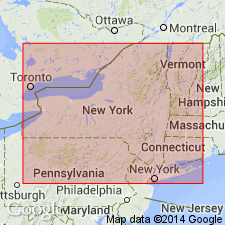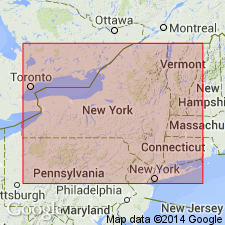
- Usage in publication:
-
- Forge Hollow member
- Modifications:
-
- Original reference
- Dominant lithology:
-
- Shale
- AAPG geologic province:
-
- Appalachian basin
Summary:
Pg. 7, 9 (stratigraphic column) [section by L.V. Rickard]. Forge Hollow member of Bertie formation. Gypsiferous shales, 25 to 40 feet thick. Overlies Fiddlers Green member; underlies Williamsville member. Age is Late Silurian.
[Type lcoality not stated.] Occurs in Clockville and Munnsville areas, central NY.
Source: US geologic names lexicon (USGS Bull. 1200, p. 1388-1389).

- Usage in publication:
-
- Forge Hollow dolomite
- Modifications:
-
- Revised
- AAPG geologic province:
-
- Appalachian basin
Summary:
Forge Hollow dolomite of Bertie group. Rank raised to formation in Bertie group. Overlies Fiddlers Green dolomite; underlies Oxbow dolomite (new). Fieldwork has not demonstrated lateral continuity of Forge Hollow and Scajaquada as indicated on present chart. Thick glacial deposits conceal these units in area where they may merge. Possibility of facies changes -- for example, Falkirk to Forge Hollow -- should not be overlooked. For the present, the distinct names are retained for western and central New York.
Source: US geologic names lexicon (USGS Bull. 1200, p. 1388-1389).
For more information, please contact Nancy Stamm, Geologic Names Committee Secretary.
Asterisk (*) indicates published by U.S. Geological Survey authors.
"No current usage" (†) implies that a name has been abandoned or has fallen into disuse. Former usage and, if known, replacement name given in parentheses ( ).
Slash (/) indicates name conflicts with nomenclatural guidelines (CSN, 1933; ACSN, 1961, 1970; NACSN, 1983, 2005, 2021). May be explained within brackets ([ ]).

